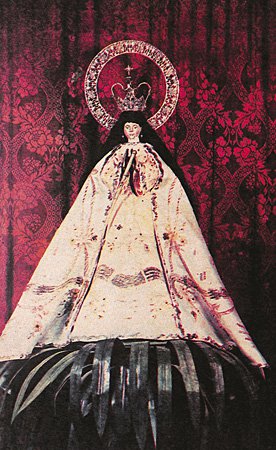Cultural Center of the Philippines
ENCYCLOPEDIA OF
PHILIPPINE ART
Our Lady of Guidance / Nuestra Señora de Guia
16th century / Wood / 52.07 cm / Ermita, Manila
Historically acclaimed as the oldest Marian image in the Philippines, the Nuestra Señora de Guia was found on 19 May 1571, the same day Miguel Lopez de Legazpi conquered the territory of Rajah Sulayman, a site now known as the City of Manila. The sculptural image was allegedly found on the shores of a village called Lagyo, enshrined on a pandan bush and being worshipped by the residents. Standing 20.5 in tall, the wooden image depicts a lady standing with her hands clasped in prayer. How the image came into the possession of the Tagalog inhabitants remains uncertain (Santos 1982, 16; Roces 1980, 55-57). The people of Lagyo said that they had been worshipping the image for a long time already and that they had experienced miracles when they implored the image in times of need (P.D.L.L.T. 1897, 6). The two friars who came with Legaspi “recognized” the image as that of the Blessed Virgin, and a chapel was built to shelter it (Roces 1980, 57).
Due to the many miracles attributed to the image particularly in aid of navigators, the image was named Nuestra Señora de Guia / Our Lady of Guidance. She was proclaimed Patroness of the Galleons, Captain of the Ships of Castille, and, by a royal decree in 1758, the Sworn Patroness of the City of Manila. She was borne in procession every time a galleon would leave the Philippine port, and was beseeched for help when the galleon’s return was delayed. The image was bestowed with a gold cane by a Spanish admiral as thanksgiving for being saved from a mishap at sea (Roces 1980, 65).
Meanwhile, Lagyo was renamed “La Ermita” or the hermitage. The shrine for the image was destroyed by various catastrophes and was rebuilt many times. The most devastating of these was the earthquake of 1771, which led to the long-term transfer of the image to the Manila Cathedral (P.D.L.L.T. 1897, 8). The image stayed in the cathedral for nearly one and a half centuries. The archbishop of Manila resisted returning the image to Ermita. This incident gave rise to the bota flores, a protest procession turned into a fiesta tradition where the residents of Ermita marched to the Manila Cathedral to pay homage and toss flowers to the image. The procession was led by a capitana in a traditional mestiza costume and featured boys in sailors’ attire. The image was eventually returned to Ermita church in 1918. Bota Flores further blossomed in grandeur on the streets of Ermita after the image’s return. It became the main event on the eve of the feast of the Nuestra Señora de Guia held every December.
Written by Dino Carlo S. Santos
Sources
P. D. L. L. T. 1897. Novena o Pagsisiam sa Nuestra Señora de Guia na Quinatha nang P.D.L.L.T. Manila: Imprenta del Colegio de Sto. Tomas.
Roces, Alejandro R. 1980b. “Bota Flores.” In Fiesta, 55-73. Quezon City: Vera Reyes.
Santos, Luz M. 1982a. “Nuestra Señora de Guia.” In Mary in the Philippines, edited by Nick M. Joaquin, 16. Manila: Luz Mendoza Santos.
